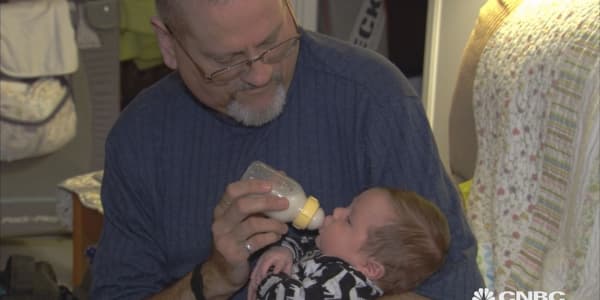As a newborn, Aidan Lamothe wore his father's wedding ring on his wrist like a bracelet. Born 11 weeks early, Aidan weighed 3 pounds and measured 16 inches long. He spent nearly the first two months of his life in intensive care as he battled jaundice and struggled to develop basic abilities, like breathing, sucking and swallowing.
"He was way too tiny and way too fragile," said Aidan's mom, Jill Teeters. "We had to leave our baby in the hospital for seven weeks, and it nearly broke our hearts."
Jill would have given anything to avoid Aidan's early arrival, but there was nothing more she could have done. "It just happened," she said.
Jill ate well and exercised regularly, attended every doctor's appointment and had no preexisting conditions. But one day in October 2007, she felt something was not right. She called her doctor just to be safe, and less than 48 hours later she was undergoing an emergency C-section.
Today, Aidan is a feisty, bright third-grader who loves to sing and play piano and aspires to become an artist. He suffers no lasting effects from his premature birth. But the question of what caused his early arrival remains unanswered, even as he celebrates his ninth birthday.
Preterm birth is the leading cause of death for infants, killing 1 million babies around the world in 2015. In the United States, nearly 1 in 10 babies is born early. While there are some inspiring stories like Aidan's, there are countless cases where children never make it home.
Statistics reveal a surprising truth. Based on the raw number of preterm births, the United States ranks sixth among countries with the most premature births, according to the World Health Organization. Some experts prefer to focus on preterm birth rate per 100 live births (or 1,000), eliminating the influence of the number of live births overall in any country. Across 184 countries, preterm birth rates range from 5 percent to 18 percent. As recently as 2010, the United States had a higher preterm birth rate than Ethiopia and Rwanda. While the United States has brought that rate down from about 12 percent to 9.6 percent in 2015, it still falls behind many other developed nations.
Many studies point to racial and ethnic disparities as the cause of this difference between the United States and other developed nations. In 2015 the rate of preterm birth among African-American women in the United States (13 percent) was about 50 percent higher than the rate of preterm birth among white women (9 percent). The rate of preterm birth is also higher among Hispanic women than white women. This trend has persisted for years.
A problem no one understands
Despite the extensive advances made in the care of premature babies, scientists still don't know what prompts preterm birth. In fact, they don't know what specifically causes labor at any time.
"It's embarrassing that we know so little about this," said Dr. Joe Leigh Simpson, senior vice president of research and global programs at the March of Dimes, a nonprofit that works to end premature birth, birth defects and infant mortality.
It's difficult to solve a problem that you don't understand.
"We don't really understand why some women go into labor early and why other women don't," said Dr. Robert Goldenberg, a professor of obstetrics and gynecology at Columbia University who has been researching preterm birth for nearly four decades. "Until we really understand that better, I don't think we're going to make much progress in terms of reducing the preterm birth rate."
Research in this area has traditionally been conducted by maternal-fetal medicine specialists, obstetricians and gynecologists, but a new line of thought is emerging through the March of Dimes: Since the factors contributing to preterm birth are so diverse, the doctors studying it should be as well.
Researchers and nonprofits around the globe have dedicated themselves to uncovering the cause. The National Institutes of Health spent $223 million on research in 2015 and projects a similar level of spending in fiscal 2017 ($230 million). The March of Dimes and the Bill & Melinda Gates Foundation have also made preterm birth a priority.
"It's going to take physicists, geneticists, biomedical experts from Silicon Valley, different types of engineers, social scientists and more," said Simpson, who oversees March of Dimes research programs.
We don't really understand why some women go into labor early and why other women don't. Until we really understand that better, I don't think we're going to make much progress in terms of reducing the preterm birth rate.Dr. Robert Goldenbergprofessor of obstetrics and gynecology, Columbia University
The organization has recently launched five transdisciplinary prematurity research centers, bringing together nearly 100 researchers from various fields to find the unknown causes of premature birth. March of Dimes will award each center $2 million annually for at least five years.
Goldenberg is not involved in any of the centers himself, but as a veteran researcher in the field, he is hopeful this approach will lead to long overdue progress.
"Since researchers in the field, including myself, have not shown ways to really effectively reduce prematurity, I think it's very useful to bring investigators who have studied heart or lung disease to see if they have some novel ideas," he said.
New research pathways
One reason researchers haven't been able to discover the cause of preterm labor is that there isn't a single cause. With countless genetic and environmental factors at play during a woman's pregnancy, it is difficult to isolate each and determine its individual effect.
Research has identified several other possible contributors to spontaneous preterm birth: inflammation or infection in the uterus, uterine or vaginal bleeding, excessive stretching of the uterus, premature rupture of fetal membranes and maternal or fetal stress.
"There's not just one cause we can attack," said Dr. Uma Reddy, medical officer in the pregnancy and perinatology branch of the National Institute of Child Health and Human Development. "There are multiple factors that go into it ... and each cause has multiple risk factors."
In 2010 about 6 infants died for every 1,000 live births in the United States, an infant mortality rate worse than 25 other developed nations. A baby born in the United States is nearly three times more likely to die in the first year of life than one born in Sweden. About 39 percent of that difference is due to a higher percentage of preterm births — a medical statistic researchers struggle to fully explain when comparing it to other developed nations. Reducing the number of preterm births to Sweden's levels could save the lives of more than 3,200 U.S.-born infants.
The March of Dimes prematurity research centers are recruiting scientists from diverse fields.
The prematurity center at Washington University in St. Louis, Missouri, is harnessing the knowledge of cardiologists and biomedical engineers who have developed pacemakers for the heart to study uterine contractions. Cardiac imaging technology today allows doctors to determine where each heartbeat comes from, the direction it goes in and how fast it moves without ever touching the heart. Researchers now want to modify this technology to produce detailed images of uterine contractions. Understanding what causes contractions to start in a pregnant woman's uterus at only 22 or 26 weeks is a vital step in learning to prevent them.
At the University of Pennsylvania, doctors who specialize in studying tendons and ligaments are now researching the cervix to determine how it affects preterm labor. "They actually think about the cervix as a tendon," said Dr. Deborah Driscoll, department chair of obstetrics and gynecology at Penn Medicine.
A pregnant woman's cervix typically softens and shortens as the baby grows, until she is ready to give birth. Researchers hypothesize that in preterm birth the cervix shortens much earlier than it should. They hope their expertise in other body systems will help them look at the cervix in a new way.
More from Modern Medicine:
New cancer drugs may damage the heart
The $5.8 billion hidden cost of the flu on the US economy
10 companies making chemotherapy easier
The prematurity centers are also examining particular genes that affect preterm labor, inflammation and infection in the uterus, social determinants and maternal and fetal stress.
"The goal, of course, is to find the biological basis that will allow us to identify ways to reduce the preterm birth rate to 5.5 percent by 2030," Simpson said. The preterm birth rate in the United States was 9.62 percent in 2015, up from 9.57 percent in 2014.
Finding the causes of preterm birth will ultimately lead to the development of therapies and drugs to prevent it.
"We will see the first fruits of this research in the next three to eight years," Simpson said. "I think it's going to move really quickly and we're going to see a plethora of discoveries in this area."
We will see the first fruits of this research in the next three to eight years. I think it's going to move really quickly.Dr. Joe Leigh Simpsonsenior vice president of research and global programs, March of Dimes
Finding the cause behind preterm birth could prevent nearly 380,000 babies a year from being born too early in the United States alone. The new research efforts could also ease the economic burden associated with preterm birth. The societal cost for preterm babies in the United States is at least $26.2 billion a year, according to one study. Infants born earlier than 32 weeks have an average hospital charge of $280,811, more than nine times as high as charges for infants born at the regular 39 to 41 weeks.
Much of that figure comes from the long-term health-care costs associated with babies born too early. Many suffer lasting deficits in brain and lung function. They are also at an increased risk for cardiovascular disease, intestinal problems, infections like pneumonia and meningitis, vision problems and hearing loss.
"It's not without repercussions, even if the baby survives," said Dr. John Ilekis, program director in the pregnancy and perinatology branch of the National Institute of Child Health and Human Development (NICHD).
An answer that can't come fast enough
The most important savings from the new research efforts takes a human dimension: Saving parents from the agony of not knowing whether their child will make it home from the hospital and feeling helpless that there is little they can do to protect their newborn.
It's a feeling that pushed Isamari Castrodad to champion the importance of prematurity research.
Isamari's son, Ismael, was delivered by an emergency C-section at 35 weeks when her amniotic fluid level dropped dramatically. Doctors still don't know what caused that. All Isamari knows is that her preparation — working out, eating healthy, taking vitamins — failed.
She watched her baby boy suffer inside an incubator that formed a barrier between mother and child.
"I couldn't touch him," Isamari recalled. "I know he's struggling just several days after he was born, so weak. The worst part is the feeling that I had no power to help him."
Fourteen years later Ismael is healthy and has even recovered from his chronic asthma, but Isamari will never forget that feeling.
Neither will Jill Teeters, who can still recall the heartbreak of having to leave Aidan in the neonatal intensive care unit.
"No one should have to leave the hospital without their baby," Jill said.
Yet she knows her family is one of the lucky ones. She and her husband, Dave, return to the NICU with Aidan each year around his birthday. They thank the doctors and nurses, bringing them cards and apples the family picked at a local orchard. As Jill puts it, "We want them to see a success story."
She hopes there are many more success stories to come. "If one less family can go through what we went through, that's a victory," Jill said. "And we need more victories."
— By Aneri Pattani, special to CNBC.com
This story is part of NBCU's Share Kindness. Follow the series on Facebook,Twitter and Instagram. #ShareKindness





